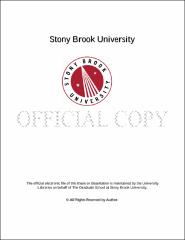| dc.identifier.uri | http://hdl.handle.net/11401/77032 | |
| dc.description.sponsorship | This work is sponsored by the Stony Brook University Graduate School in compliance with the requirements for completion of degree. | en_US |
| dc.format | Monograph | |
| dc.format.medium | Electronic Resource | en_US |
| dc.language.iso | en_US | |
| dc.publisher | The Graduate School, Stony Brook University: Stony Brook, NY. | |
| dc.type | Dissertation | |
| dcterms.abstract | Titanium dioxide (TiO$_2$) has attracted significant interest over the years as a photocatalyst for the photooxidation of organic compounds. This type of chemistry finds numerous practical applications in areas such as environmental remediation and self-cleaning coatings. The work described herein employs pump-probe laser techniques to study the photooxidation dynamics of acetone, butanone, ethanol and 2-propanol over a model TiO$_2$(110) photocatalyst. Studies of model catalysts under ideal, ultra-high vacuum (UHV) conditions allow for detailed, mechanistic information to be obtained. A common characteristic of all these photooxidation reactions is that they proceed by ejection of methyl or ethyl (in the case of butanone) radicals from the surface. The pump-probe laser techniques used here provide information regarding the kinetic energy and internal state distributions of these radical species. Previous studies of acetone photooxidation have shown that this molecule, when co-adsorbed with molecular oxygen on a TiO$_2$ surface, forms a diolate species that can photooxidize to produce adsorbed acetate and gas-phase methyl radicals. These radicals desorb with a kinetic energy distribution characterized by two channels. In an attempt to better understand this bimodal distribution, state-resolved measurements were made of the methyl radical $\nu_2$ ``umbrella mode'' vibration. It was found that methyl radicals which desorbed promptly from the surface (E$_{kin}$ = 0.15 eV) had a cold vibrational distribution in this mode which was characterized by a T$_{vib}=151\pm15$ K. While this distribution was colder than that measured in the gas phase for acetone photodissociation, the rotational energy distribution was comparable to that obtained in gas-phase measurements (T$_{rot} = 325\pm25$ K). Kinetic energy distributions taken at $\nu_2(v=0)$ and $\nu_2(v=1)$ show that vibrationally excited methyl radicals have $\sim35$ meV less energy overall than those which are not. Together these results suggest a late transition state for acetone photooxidation and show that vibrationally excited methyl radicals have less energy in the form of kinetic energy. Butanone photooxidation on TiO$_2$ has been previously shown to proceed via ejection of both methyl and ethyl radicals into vacuum. Early experiments on this system using mass spectrometry indicated that butanone photooxidation may also produce secondary organic products. Subsequent measurements of the kinetic energy of these various products revealed that these products are in fact fragments of desorbing ethyl radicals. Work presented here used this system as a test case to demonstrate a technique called pixel-imaging mass spectrometry (PImMS) in particular for surface photochemistry experiments. When used in conjunction with velocity map imaging, this technique can help distinguish primary photoproducts from fragments based on differences in angular distributions between these species. When compared with kinetic energy measurements and conventional imaging techniques, this technique is far less time consuming and maximizes the amount of data that can be obtained under identical experimental conditions. The photooxidation of ethanol and 2-propanol was also studied in an effort to make mechanistic connections between alcohol and aldehyde/ketone photooxidation. While previous studies of these molecules has shown that the first step in photooxidation is the photo-dehydrogenation to either acetaldehyde or acetone. In this work, it is demonstrated that these reactions also proceed via methyl radical ejection into vacuum. By comparing the kinetic energy distributions measured here with those previously obtained for acetaldehyde and acetone photooxidation, it is concluded that these radicals are produced via the photooxidation of the initial aldehyde/ketone photoproduct. Finally, details for the design of a new time-of-flight spectrometer for ultrafast imaging studies is presented. This instrument is designed to resolve the angular distributions of desorbing molecules by the velocity map imaging technique. The performance of the detector will be demonstrated on the basis of computer simulations as well as experimental data for the gas-phase photolysis of methyl iodide | |
| dcterms.available | 2017-09-20T16:51:43Z | |
| dcterms.contributor | White, Michael G | en_US |
| dcterms.contributor | Rodriguez, Jose | en_US |
| dcterms.contributor | Camillone, III, Nicholas. | en_US |
| dcterms.contributor | Sears, Trevor | en_US |
| dcterms.creator | Kershis, Matthew David | |
| dcterms.dateAccepted | 2017-09-20T16:51:43Z | |
| dcterms.dateSubmitted | 2017-09-20T16:51:43Z | |
| dcterms.description | Department of Chemistry | en_US |
| dcterms.extent | 120 pg. | en_US |
| dcterms.format | Monograph | |
| dcterms.format | Application/PDF | en_US |
| dcterms.identifier | http://hdl.handle.net/11401/77032 | |
| dcterms.issued | 2016-12-01 | |
| dcterms.language | en_US | |
| dcterms.provenance | Made available in DSpace on 2017-09-20T16:51:43Z (GMT). No. of bitstreams: 1
Kershis_grad.sunysb_0771E_12825.pdf: 40233609 bytes, checksum: 00ea246952629d32331f7e458a43c33e (MD5)
Previous issue date: 1 | en |
| dcterms.publisher | The Graduate School, Stony Brook University: Stony Brook, NY. | |
| dcterms.subject | alcohol, ketone, photochemistry, photoooxidation, surface science, titanium dioxide | |
| dcterms.subject | Chemistry | |
| dcterms.title | Dynamics of Alcohol and Ketone Photooxidation Reactions on TiO2(110) | |
| dcterms.type | Dissertation | |

